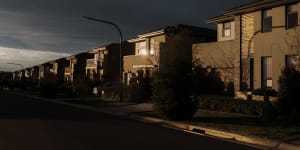While the Boomers were the largest cohort in 184 of Sydney’s 323 suburbs in 2011,that figure has fallen to 88,while the number of suburbs where Gen Y is the biggest has increased from 33 to 168.
The displacement of the Boomers and Generation X over the past decade is shown by census data – replicated suburb-by-suburb in an interactive map produced by theHerald – that also reveals how parts of the south-west growth corridor house the city’s highest concentration of Generation Zs.

Generation X,born between 1966 and 1980,remains dominant in some parts of Sydney,especially around the north shore and sections of the northern beaches – as well as the Balmain peninsula and Rozelle.
Simon Kuestenmacher of The Demography Group said the statistics told the story of the past 10 years of Generation Y (Millennials) leaving their childhood homes in suburbia and moving to the inner city – except for the places they cannot afford and where there is little new housing.
Suburbs exempt from the Gen Y takeover that are still dominated by the Baby Boomers included Vaucluse,Rose Bay and Bellevue Hill in the eastern suburbs,and Mosman,Hunters Hill,Riverview and Greenwich in the north.
“There are very few Millennials that can compete with Baby Boomers on those prime property prices,” Kuestenmacher said. “They’re great NIMBY councils,they protect the heritage of their suburbs,so they make sure that not enough housing development is occurring in their suburbs.”
Young Millennials Jonathon Leonard,29,and Rachel O’Brien,27,live in Chatswood,at the perimeter of Gen Y territory on the north shore. Leonard says the northern Sydney suburbs popular with people his age are the areas with more apartments,such as Kirribilli,as no one can afford a house.

Jonathon Leonard and Rachel O’Brien are younger Millennials who live in Chatswood,on Sydney’s north shore.James Brickwood
Leonard likes the area because it’s walkable and close to family;his mother and brother live nearby in Lane Cove. “Younger people moving here tend to be the ones who want to be close to family but still get their pretty nice neighbourhood as well,” he says.
Boomers are still the largest cohort in some slices of the inner west;Concord,Five Dock,Croydon and Drummoyne. But large swaths of the inner west where Gen X dominated in 2011 are now Gen Y strongholds,such as Marrickville,Petersham,Stanmore,Leichhardt and Annandale.
The fabric of Haberfield and Summer Hill has changed quickly;Gen X replaced the Boomers as the biggest generation there in 2016,only to be replaced by Gen Y last year.
Western Sydney suburbs such as Penrith,Blacktown and Schofields were more likely to go straight from Boomers to Millennials,who are now aged 26 to 41,buying homes and starting families.

Outer suburbs like Schofields house Millennials looking to start families.James Brickwood
Kuestenmacher said push would come to shove for wealthy Baby Boomers as they age and require – or seek out – care in their low-density enclaves,rather than moving into retirement villages. For carers to live nearby,those areas will need to build more housing and Boomers “will need to curb their NIMBYism”,he says.
The Australian Bureau of Statistics noted in June that an increasing number of Baby Boomers – 7.4 per cent – now required assistance with core activities. Last year’s census marked the first time that Generation Y matched the size of the Baby Boomers,traditionally the largest generation;they now both account for 21.5 per cent of the population.
Australian National University demographer Liz Allen said the basic thrust of the change was that Boomers were ageing and Generation Y was growing through immigration,and it was interesting that the Millennial boom suburbs roughly followed the main east-west public transport corridor.
Generations can be appealing ways to think about cohorts of people – especially those shaped by major developments in world affairs,technology or popular culture – but they are invented terms and lack scientific merit. And not all generations are equal;the Baby Boomers span 20 years of births,from 1946 to 1965,compared to 15 years for other generations.
Allen also cautions that while Millennials may now be numerically dominant,“the fact they are not politically or socially dominant suggests that there’s a pretty significant power struggle going on”.
“We see this reflected in housing affordability and all other manner of aspects where there is this generational warfare,” she says.
Generation Z,born between 1996 and 2010,made up the largest percentage of the population in parts of the south-west such as Bass Hill and Prestons,or further out near Luddenham and Macquarie Fields. Kuestenmacher said this could reflect the presence of larger migrant households with children still at home.
The Morning Edition newsletter is our guide to the day’s most important and interesting stories,analysis and insights..